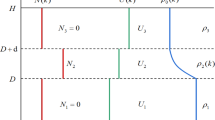Abstract
Based on a nonhydrostatic numerical ocean model developed by one of the authors, the interaction of an internal solitary wave with a step-type topography was investigated. Over the step topography, the flow pattern could be classified into three categories: 1) the propagation and spatial structure of the internal solitary wave was little influenced by the bottom topography, 2) the internal solitary wave was significantly distorted by the blocking effect of the topography without the occurrence of wave breaking and 3) the internal solitary wave was broken as it encountered and passed over the bottom topography. A detailed description of the processes leading to wave breaking is given in this paper together with energy budget analysis. The results revealed that the maximum of the energy dissipation rate is no more than 40%, which is consistent with available experimental data.
Similar content being viewed by others
References
Apel, J. R., J. R. Holbrock, A. K. Liu, and J. J. Tsai, 1985. The Sulu Sea internal soliton experiment, J. Phys. Oceanogr., 15(12): 1625–1651.
Apel, J. R., L. A. Ostrovsky, and Yu. A. Stepanyants, 1995. Internal solitons in the ocean, Technical Report. MERCJRA-0695, the Johns Hopkins University, USA.
Benjamin, T. B., 1967. Internal waves of permanent form in fluids of great depth. J. Fluid Mech., 29: 559–592.
Chen, C. Y., R. C. Hsu, M. H. Chen, H. H. Chen, and C. F., Kuo, 2007a. An investigation on internal solitary waves in a two layer fluid: propagation and reflection from steep slopes. Ocean Eng., 34: 171–184.
Chen, C. Y., R. C., Hsu, M. H., Chen, H. H., Chen, C. F., Kuo and M. H., Cheng, 2007b. Laboratory observations on internal solitary wave evolution on steep and inverse uniform slopes. Ocean Eng., 34: 157–170.
De Silva, I. P. D., J. Imberger, and G. N. Ivey, 1997. Localized mixing due to a breaking internal wave ray at a sloping bed. J. Fluid Mech. 350: 159–177.
Diebels, S., B. Schuster, and K. Hutter, 1994. Nonlinear internal waves over variable topography, Geophys. Astrophys. Fluid Dyn., 76(1): 165–192.
Djordjevic, V. D., and L. G. Redekopp, 1978. The fission and disintegration of internal solitary waves moving over Two-dimensional topography. J. Phys. Oceanogr., 8(6): 1016–1024.
Duda, T. F., J. F. Lynch, J. D. Irish, R. C. Beardsley, S. R. Ramp, C. S. Chiu et al., 2004. Internal tide and nonlinear internal wave behavior at the continental slope in the northern South China Sea. IEEE J. Ocean Eng., 29(4): 1105–1130.
Gerkema, T. and J. T. F. Zimmerman, 1994. Generation of nonlinear internal tides and solitary waves. J. Phys. Oceanogr., 25(1): 1081–1094.
Halpern, D., 1971. Observations of short period internal waves in Massachusetts Bay. J. Mar. Res., 29: 116–132.
Helfrich, K. R., 1992. Internal solitary waves breaking and run-up on a uniform slope. J. Fluid Mech., 243: 133–154.
Kao, T. W., F. S. Pan, and D. Renouard, 1985. Internal solitons on the pycnocline: generation, propagation, and shoaling and breaking over a slope. J. Fluid Mech., 159: 19–53.
Koop, C., and G. Butler, 1981. An investigation of internal solitary wave in a two fluid system. J. Fluid Mech., 112: 225–251.
Long, R. R., 1956. Solitary waves in one and two fluid systems. Tellus, 8: 460–471.
Maxworthy, T., 1979. A note on the internal solitary waves produced by tidal flow over three-dimensional ridge. J. Geophys. Res., 84(C1): 338–346.
Michallet, H., and E. Barthelemy, 1998. Experimental study of solitary waves. J. Fluid Mech., 366: 159–177.
Michallet, H., and G. M. Ivey, 1999. Experiments on mixing due to internal solitary waves breaking on uniform slopes. J. Geophys. Res., 104(C6): 13 467–13 477.
Osborne, A. R., and T. I. Burch, 1980. Internal solitons in the AndamanSea. Nature, 208: 451–469.
Osborne, A. R., T. I. Burch, and R. I. Scarlet, 1978. The influence of internal waves on deep water drilling. J. Pet. Tech., 30: 1497–1509.
Ostrovsky, L. A., and Yu. A. Stepanyants, 1989. Do internal solitons exist in the ocean? Rev. Geophys., 27(3): 293–310.
Sandstrom, H., and J. A. Elliott, 1984. Internal tide and solitons on the Scotian Shelf: A nutrient pump at work. J. Gephys. Res., 89(C10): 6415–6426.
Sveen, J. K., Y. K. Guo, P. A. Davies, and J. Grue, 2002. On the breaking of internal solitary waves at a ridge. J. Fluid Mech. 469: 161–188.
Vlasenko, V. I., and K. Hutter, 2002. Numerical experiments on the breaking of solitary internal waves over a slope-shelf topography. J. Phys. Oceanogr., 32(6): 1779–1793.
Vlasenko, V., N. Stashchuk, and K. Hutter, 2005. Baroclinic Tides: Theoretical Modeling and Observational Evidence. Cambridge University Press, Cambridge, 371pp.
Wessels, F., and K. Hutter, 1996. Interaction of internal waves with a topographic sill in a two-layered fluid. J. Phys. Oceanogr., 26(1): 5–20.
Xu, Z. T., G. J. Shen, and S. P. Shen, 2005. A correction of the 2D KdV equation of Djordjevic and Redekopp in exponentially stratified fluid. Acta Mech. Sin., 21(4): 346–352.
Author information
Authors and Affiliations
Corresponding author
Rights and permissions
About this article
Cite this article
Xu, Z., Li, Q., Chen, X. et al. Numerical simulation on the interaction of an internal solitary wave with a step-type topography. J. Ocean Univ. China 7, 119–123 (2008). https://doi.org/10.1007/s11802-008-0119-9
Received:
Accepted:
Published:
Issue Date:
DOI: https://doi.org/10.1007/s11802-008-0119-9



